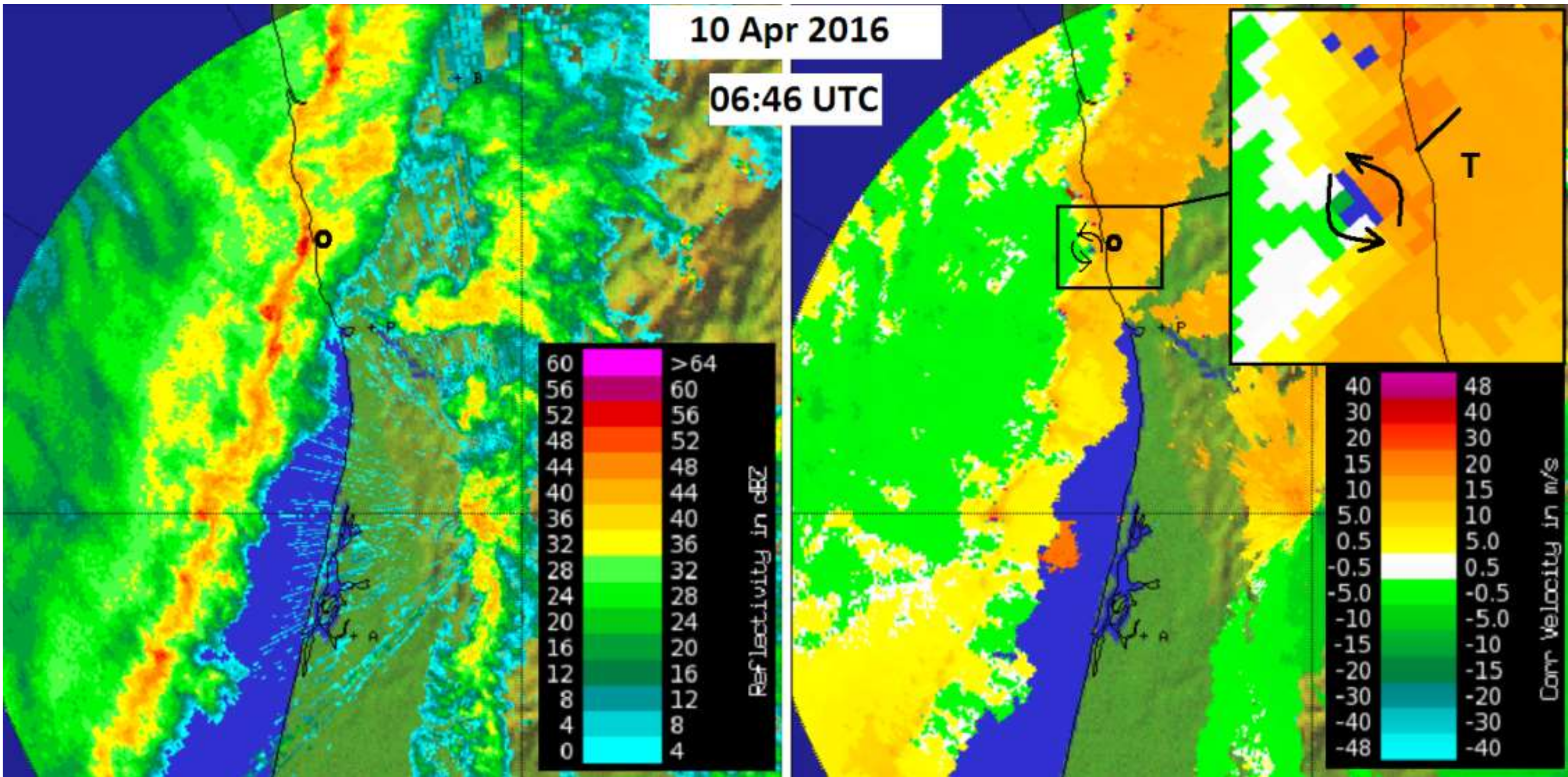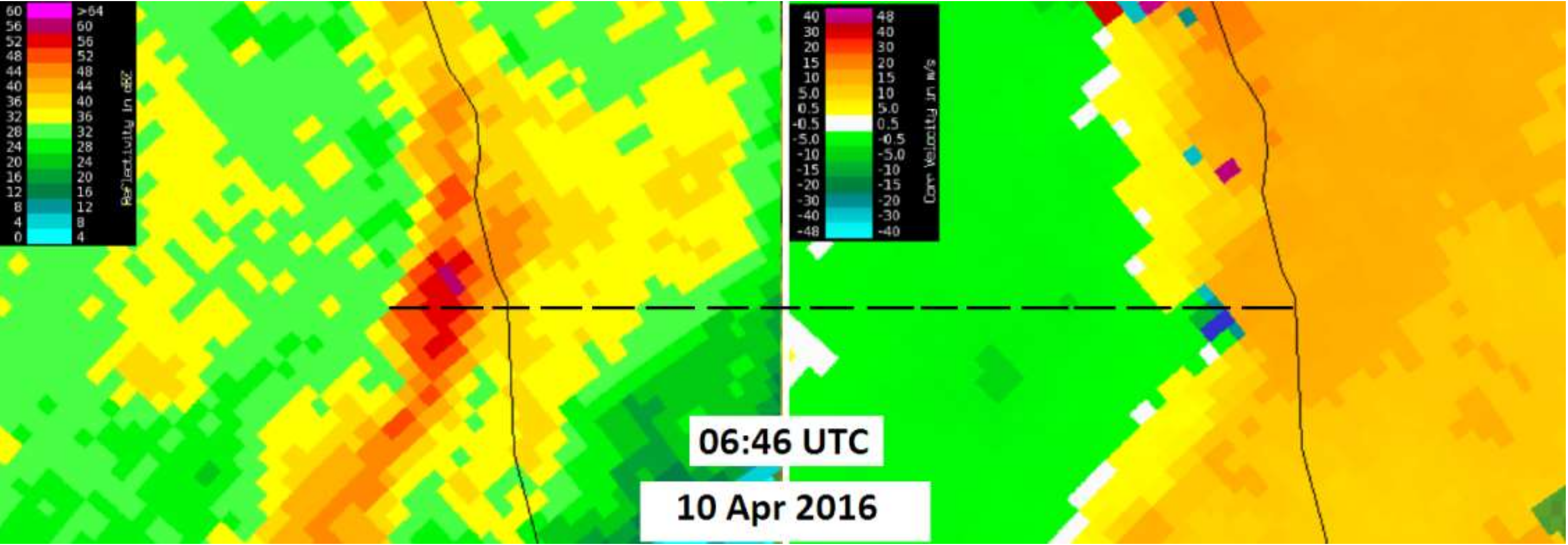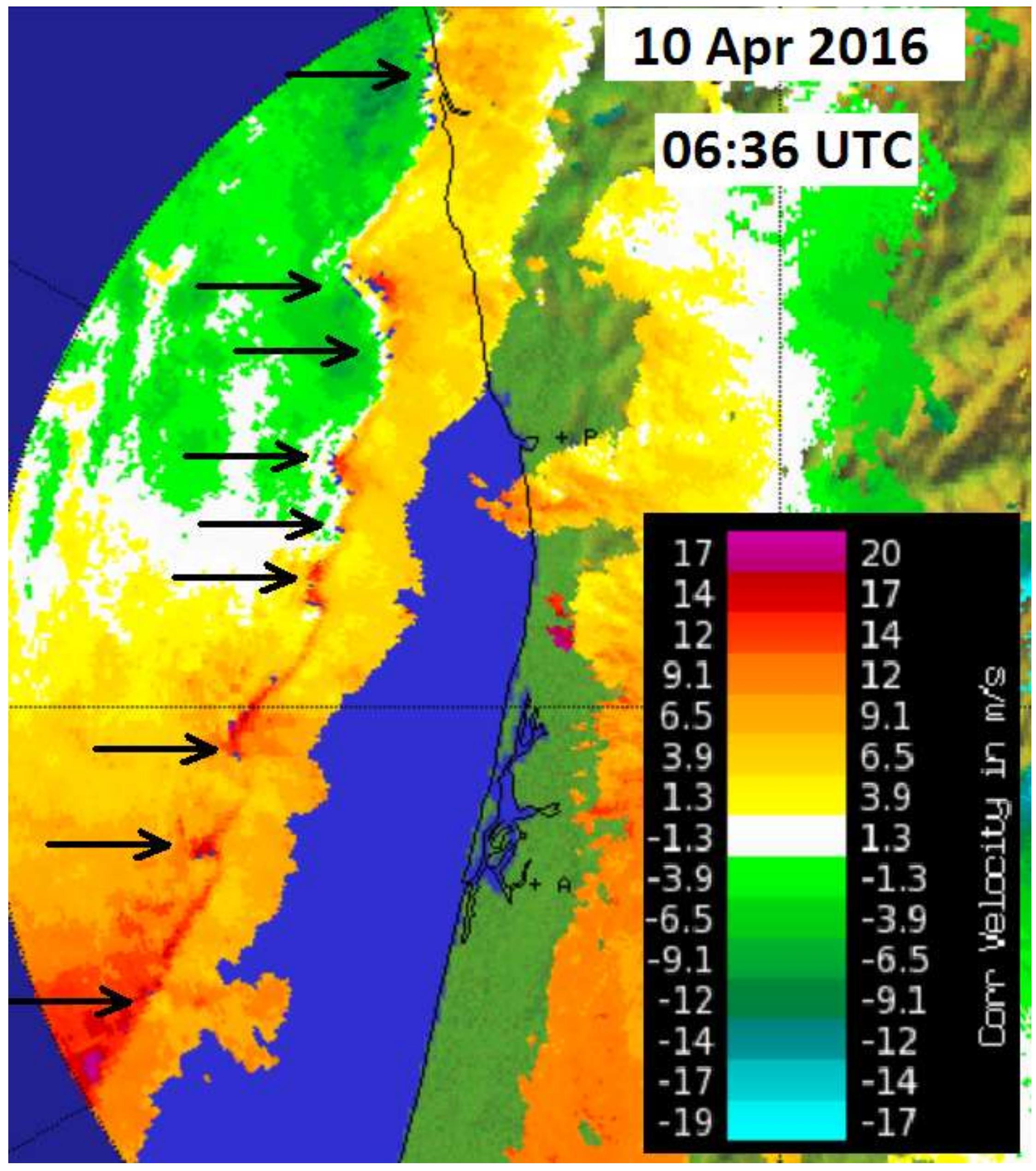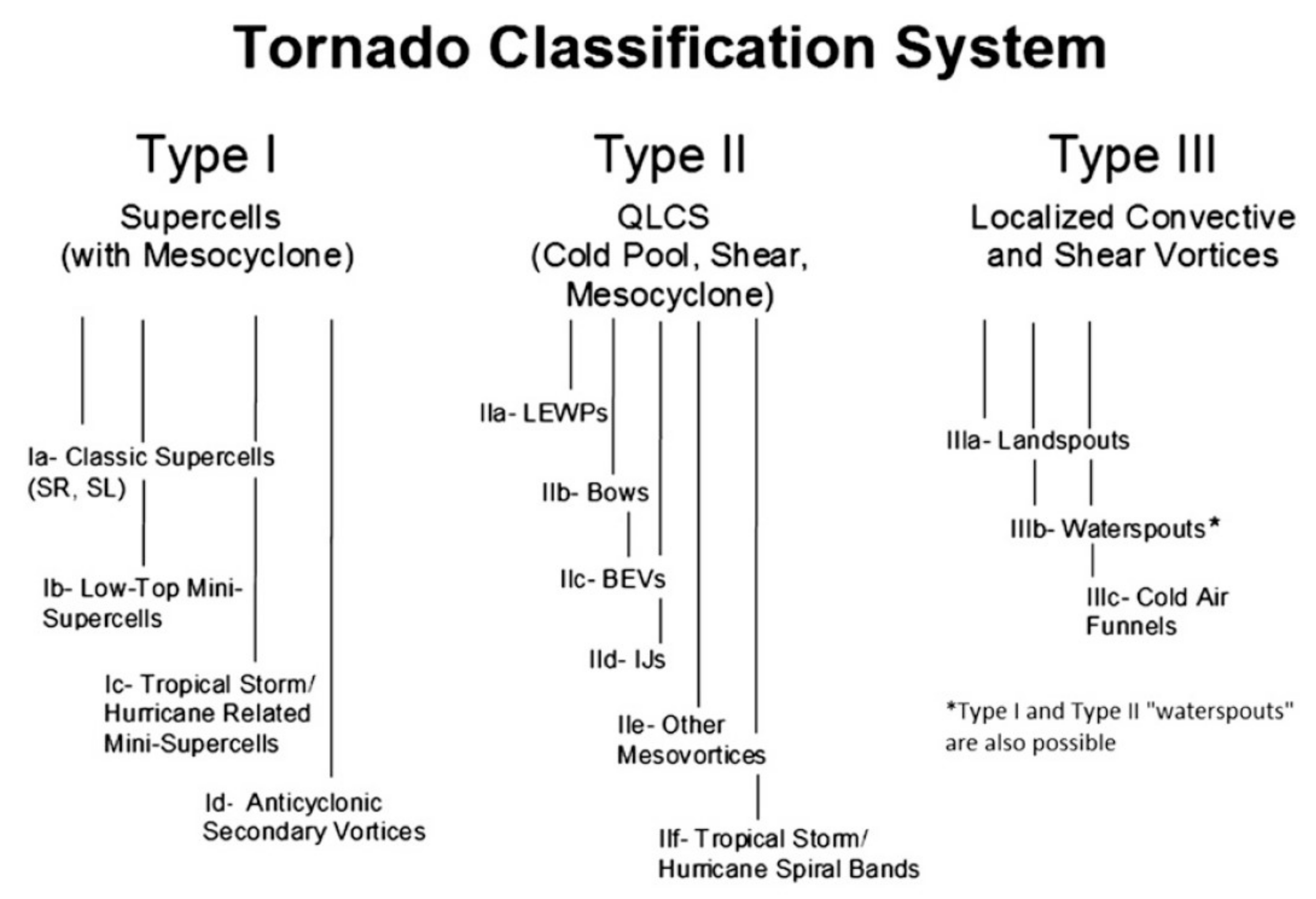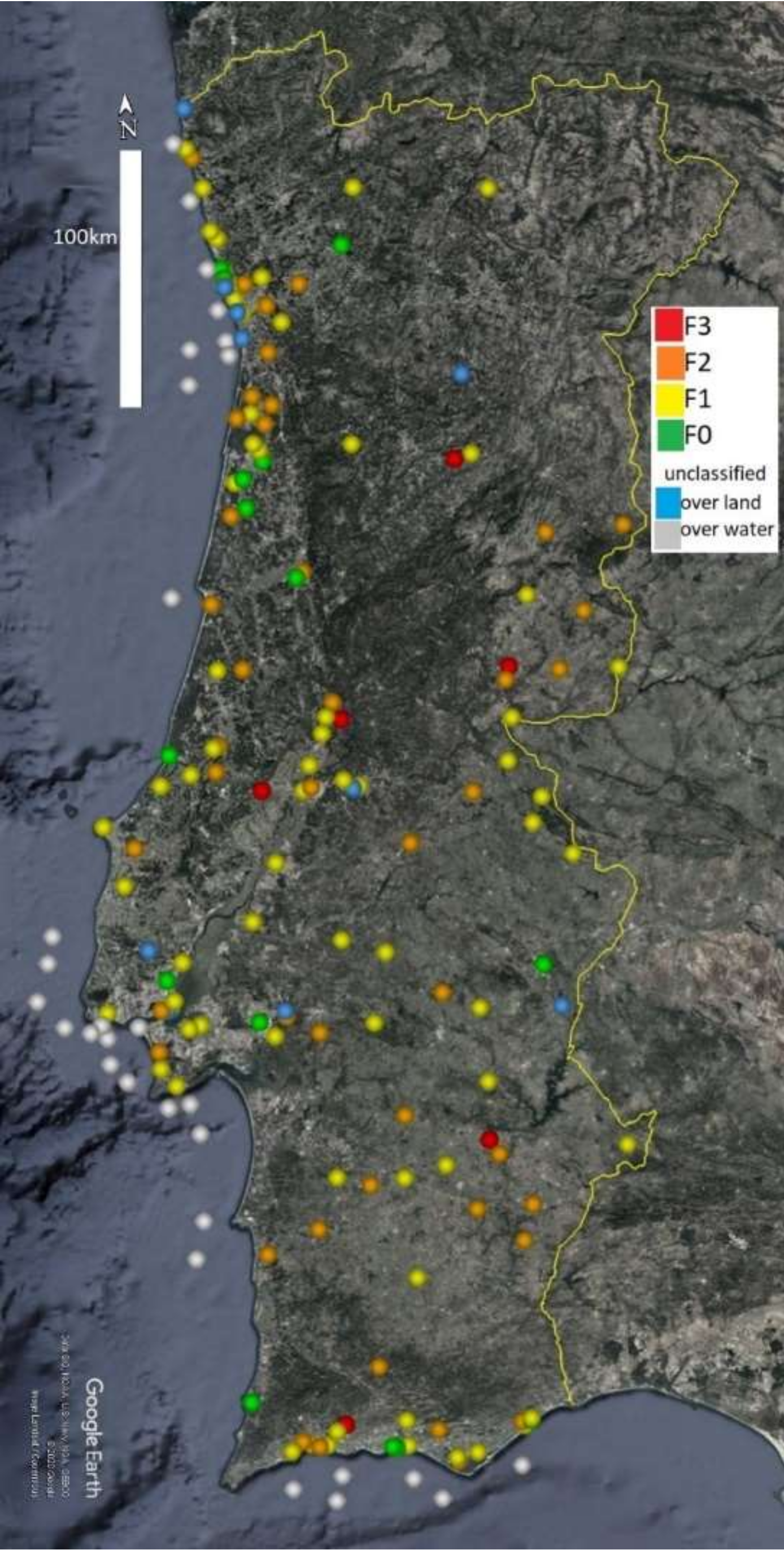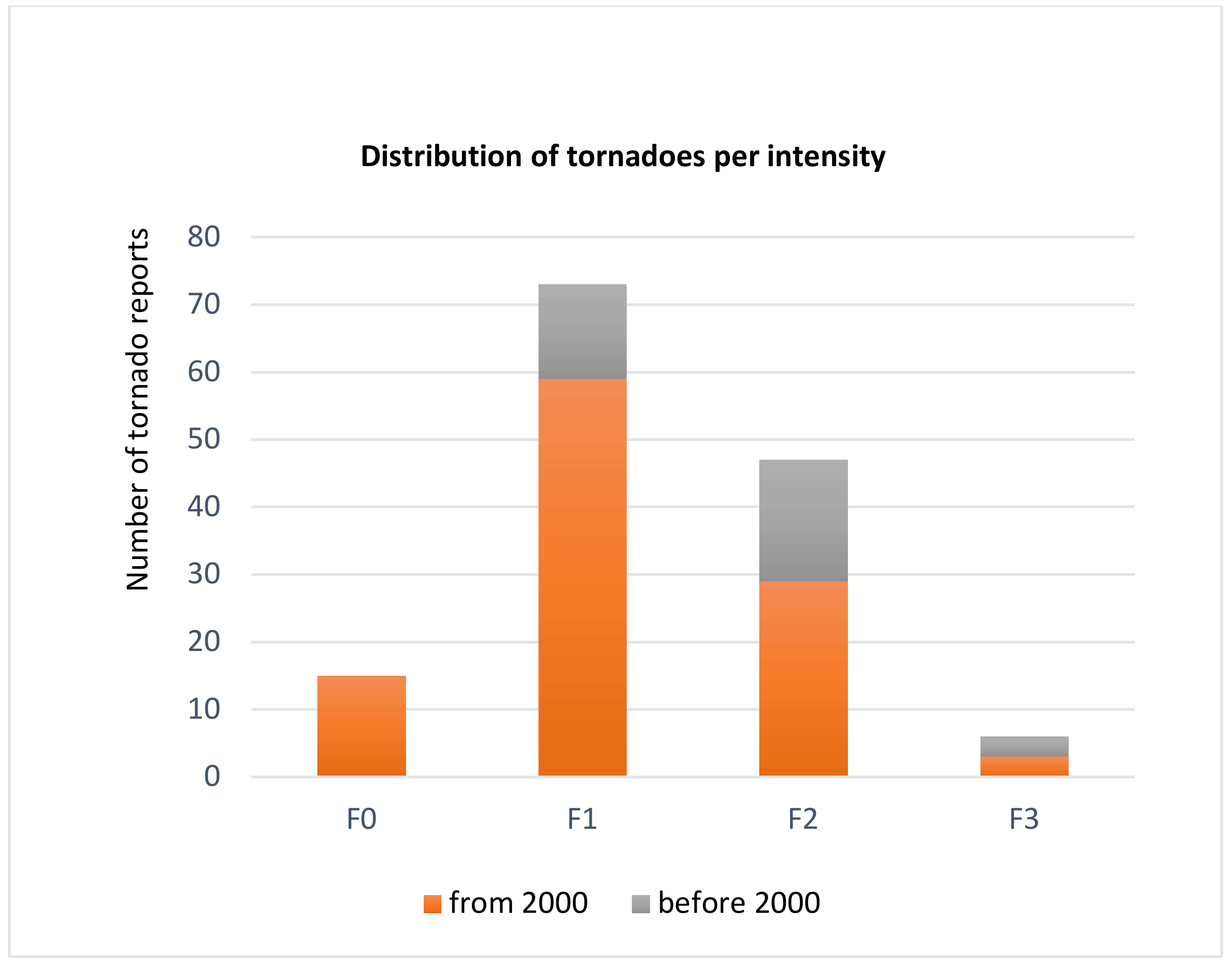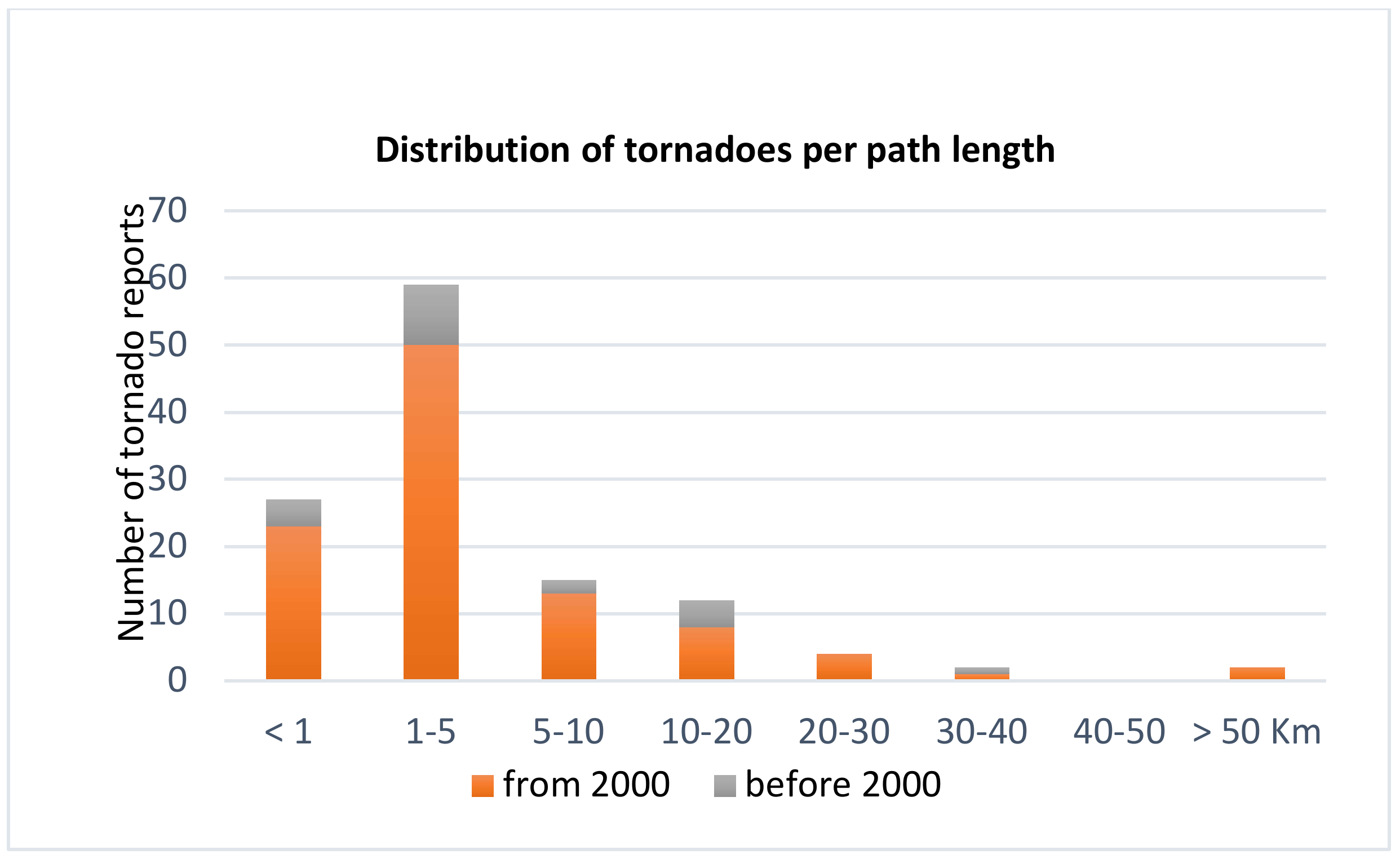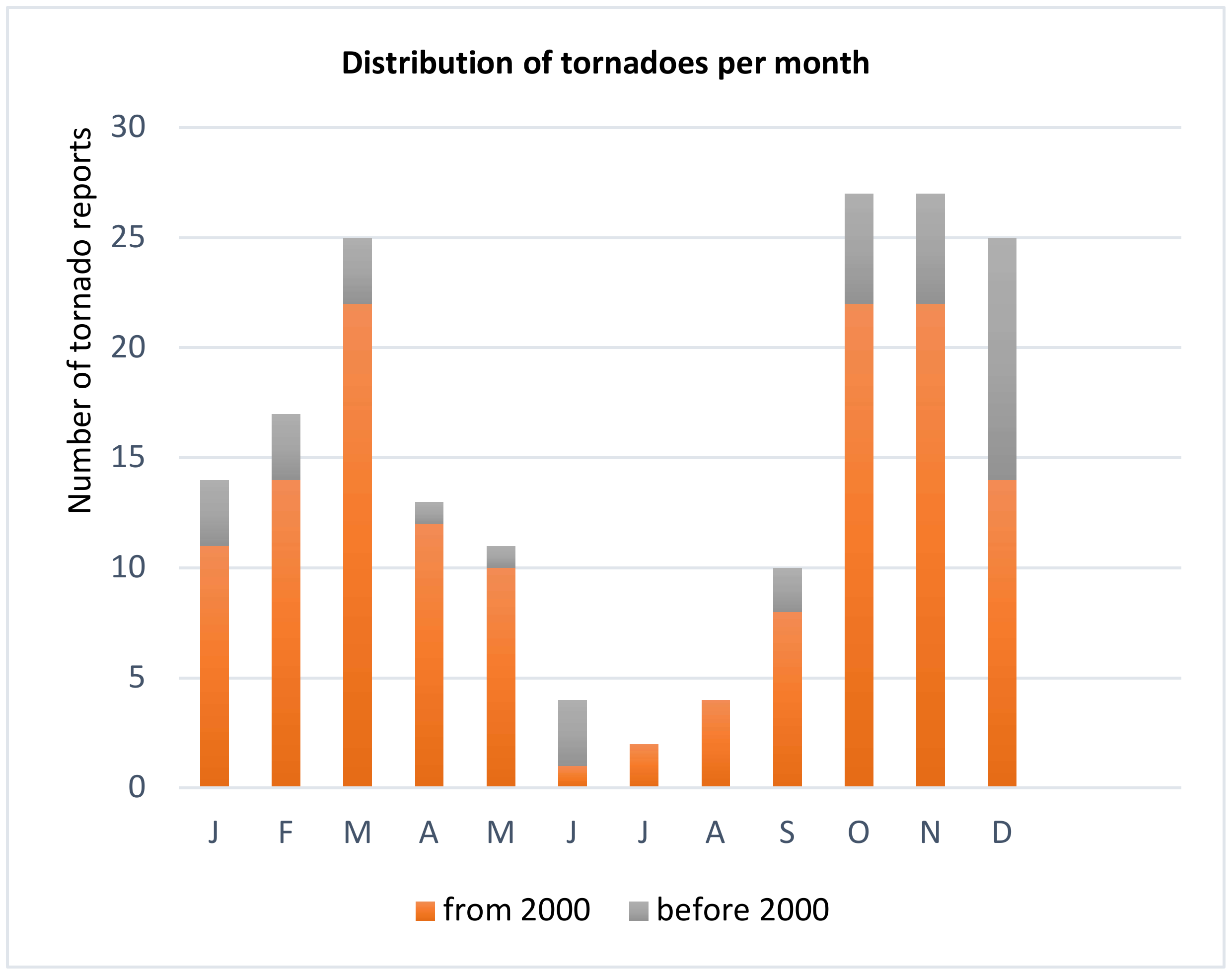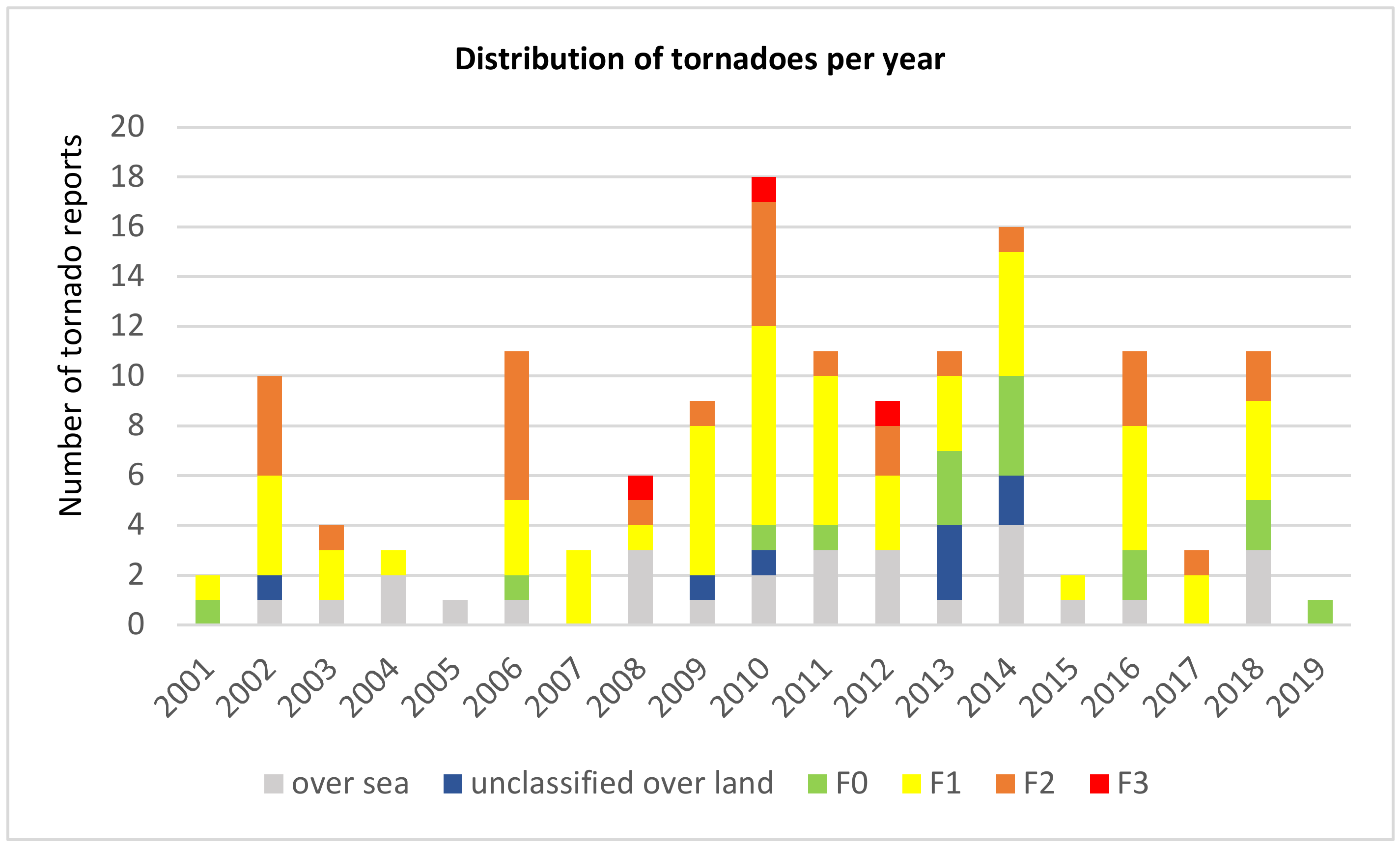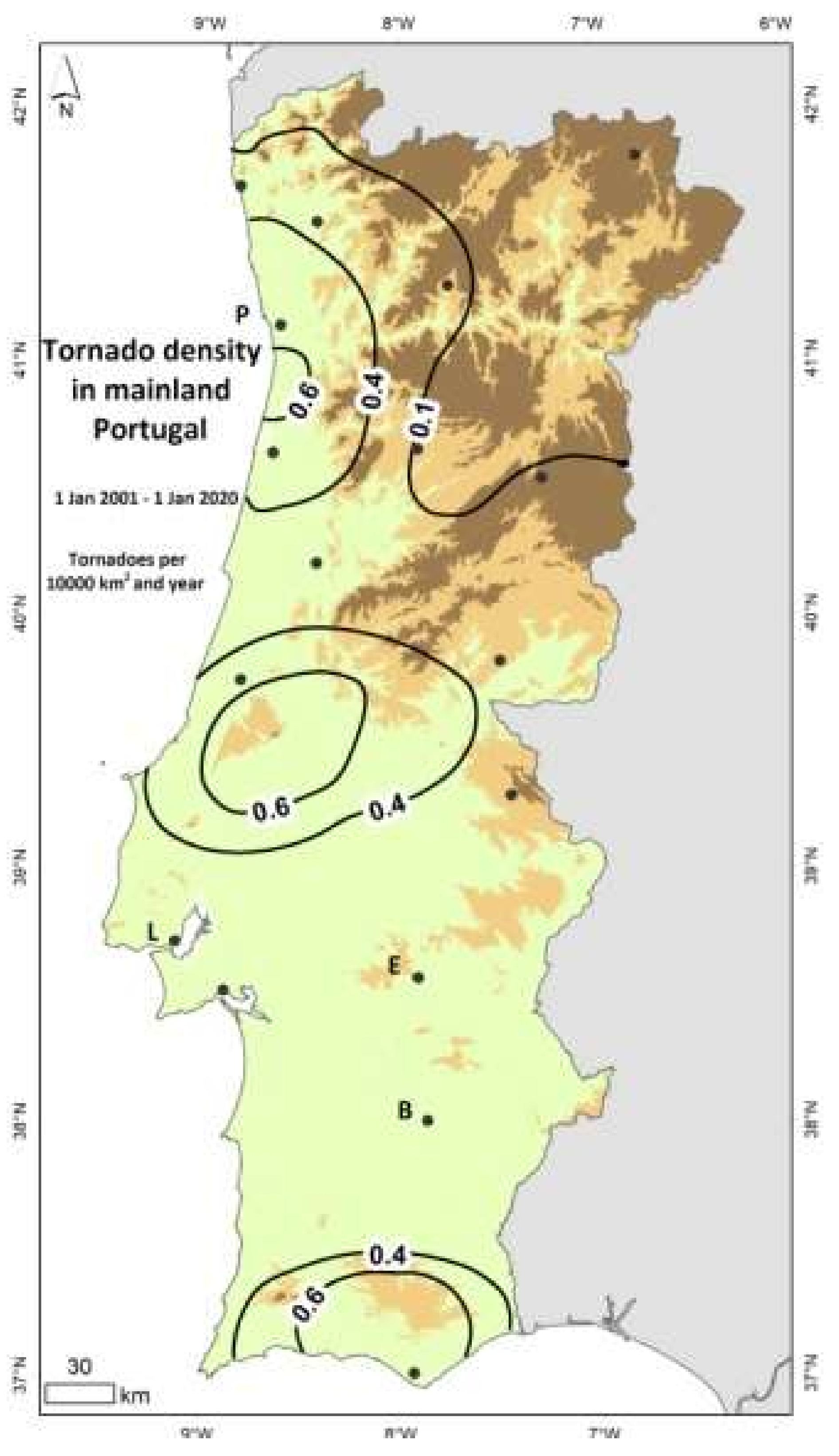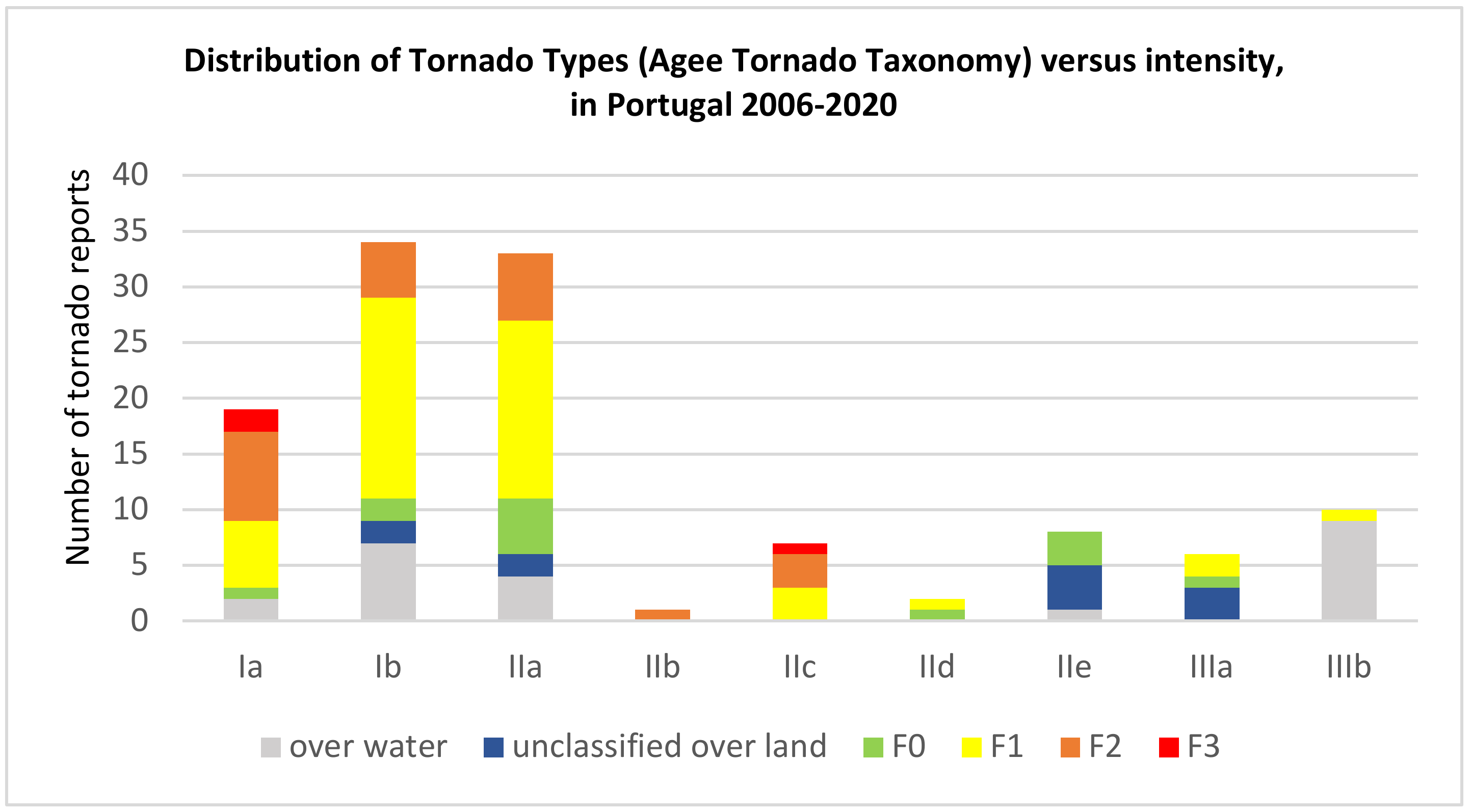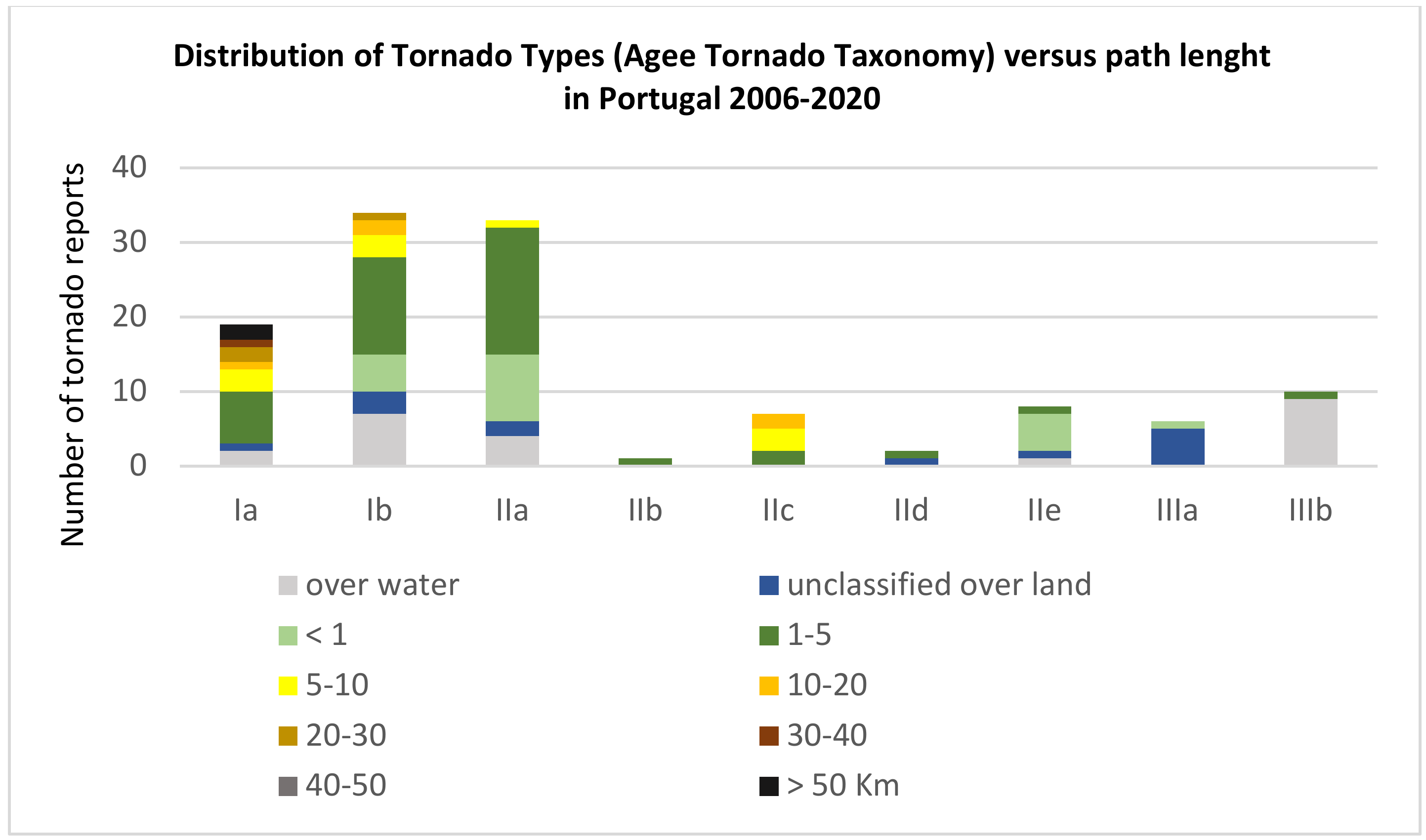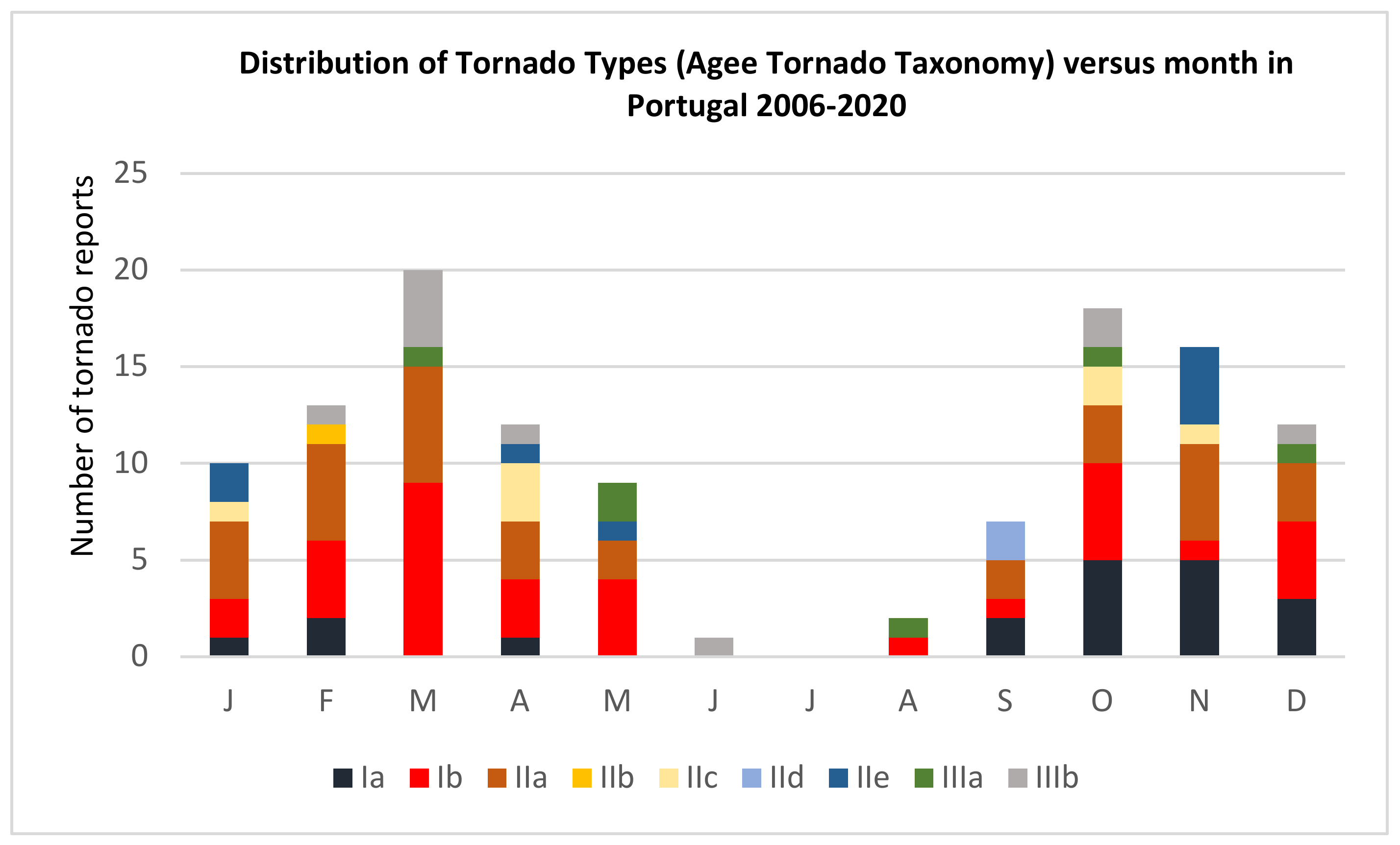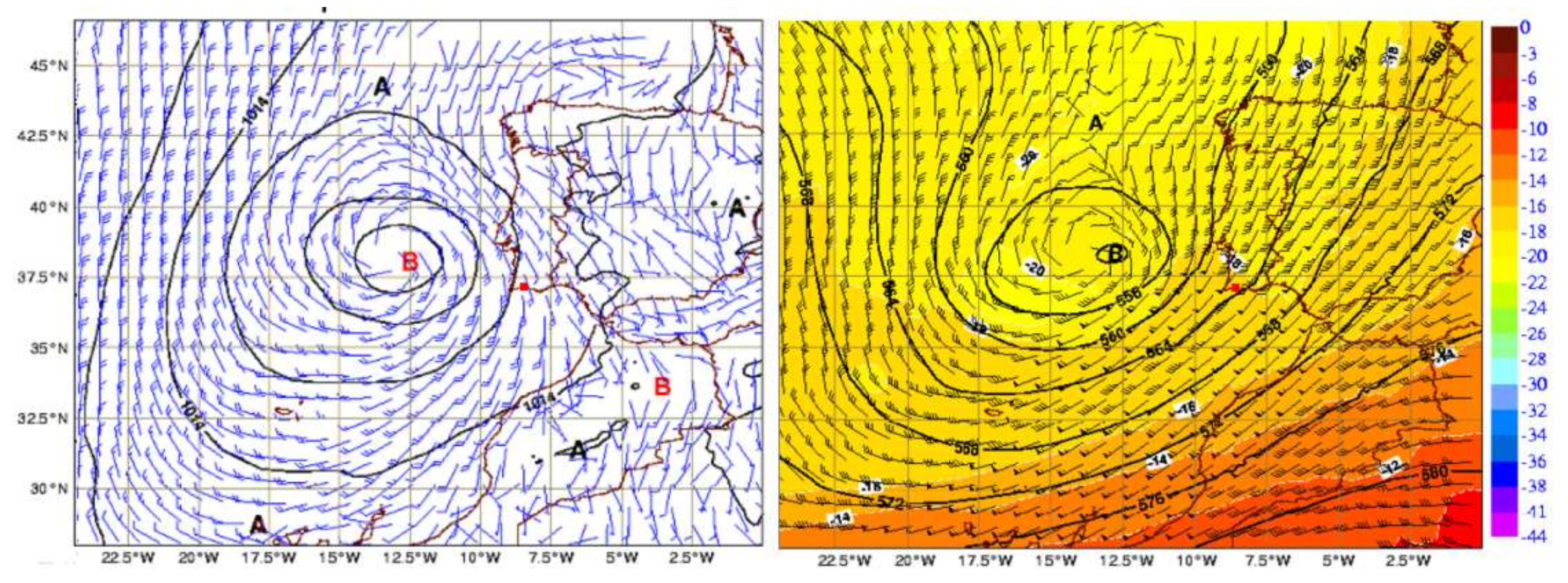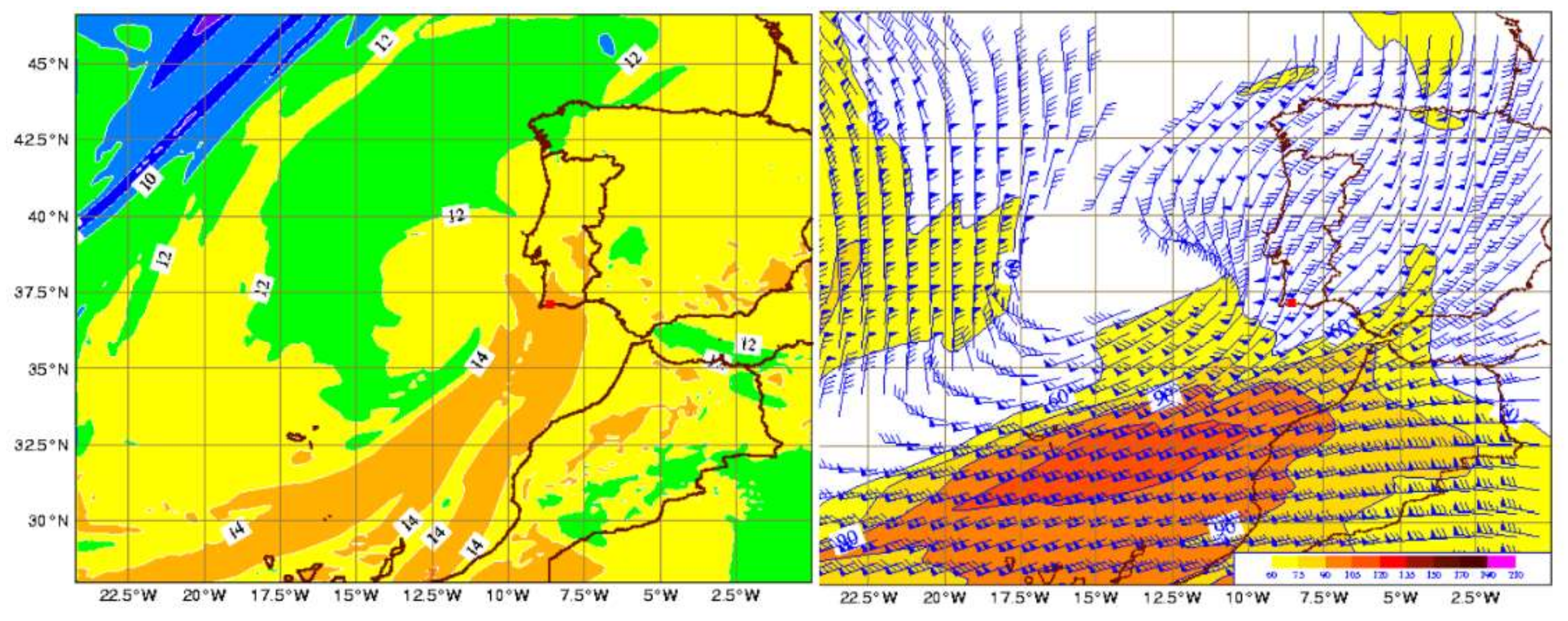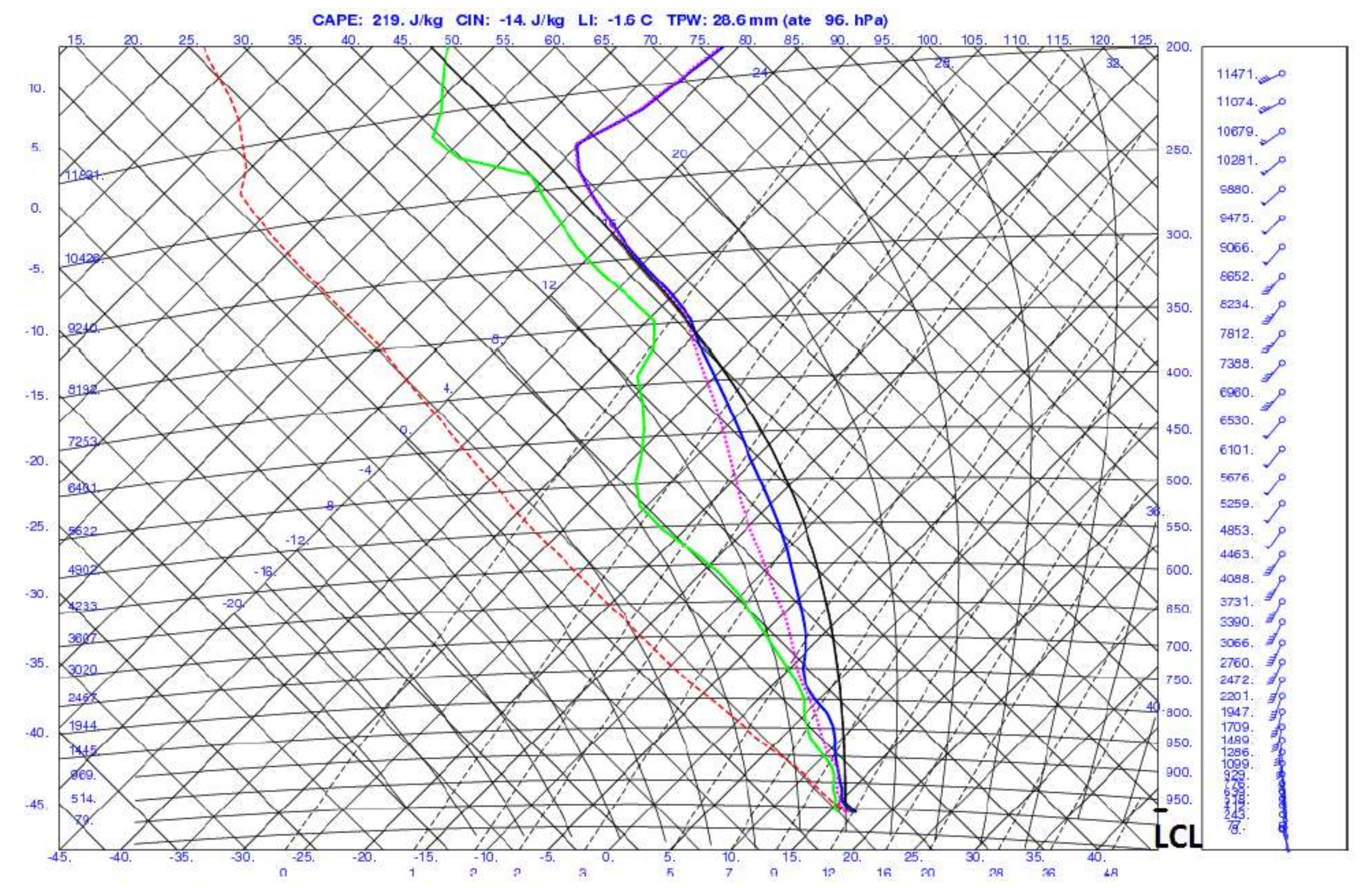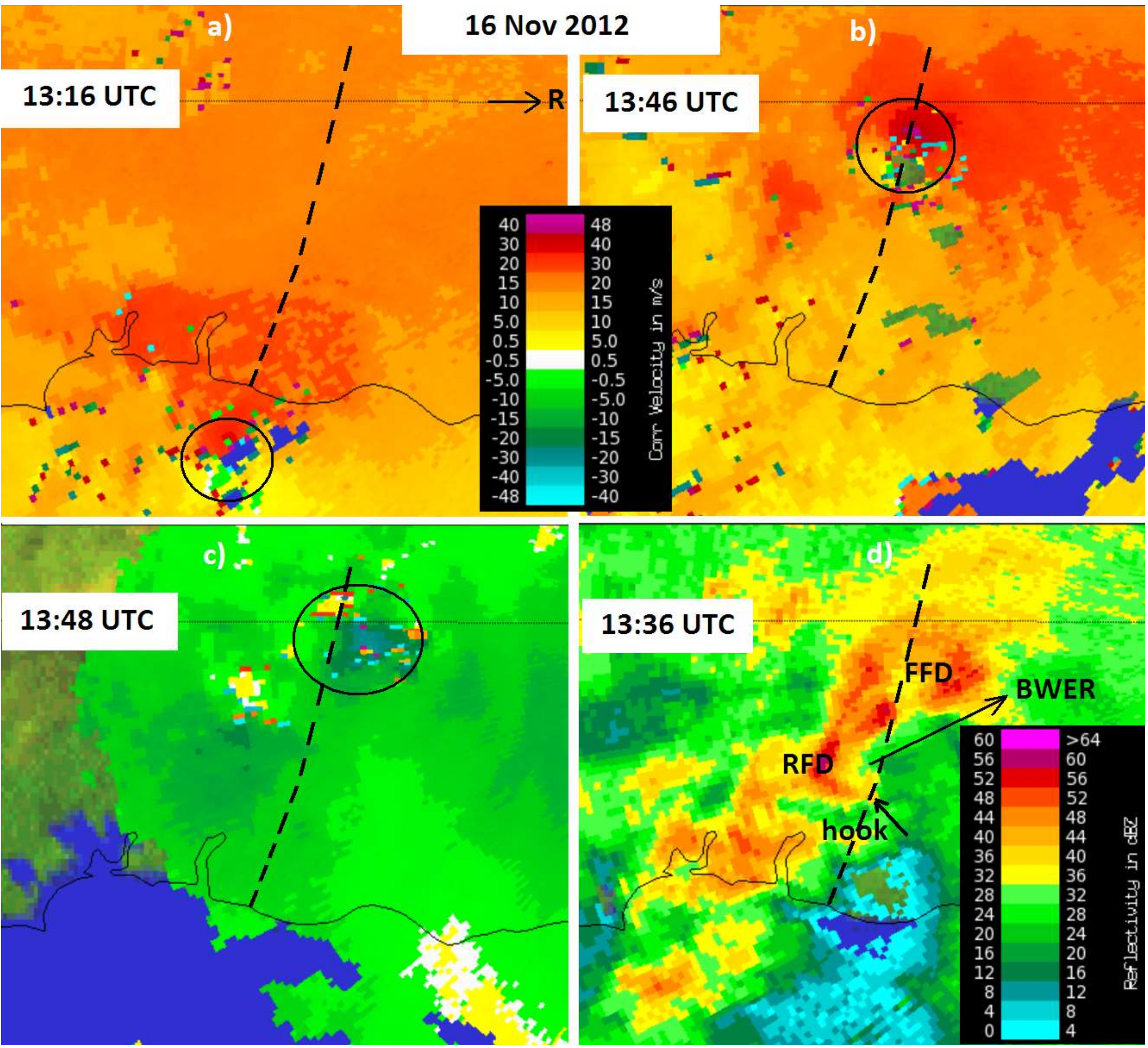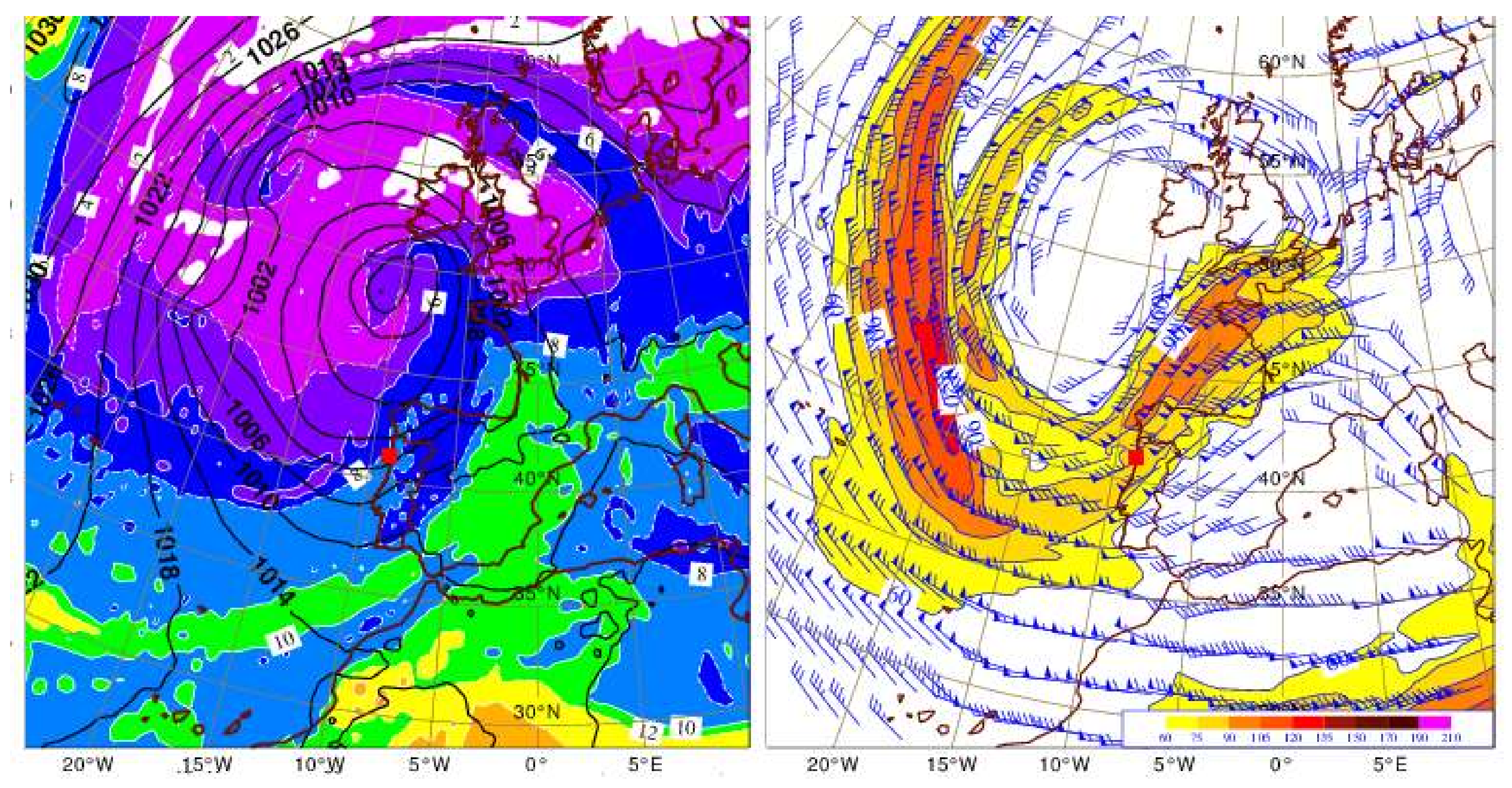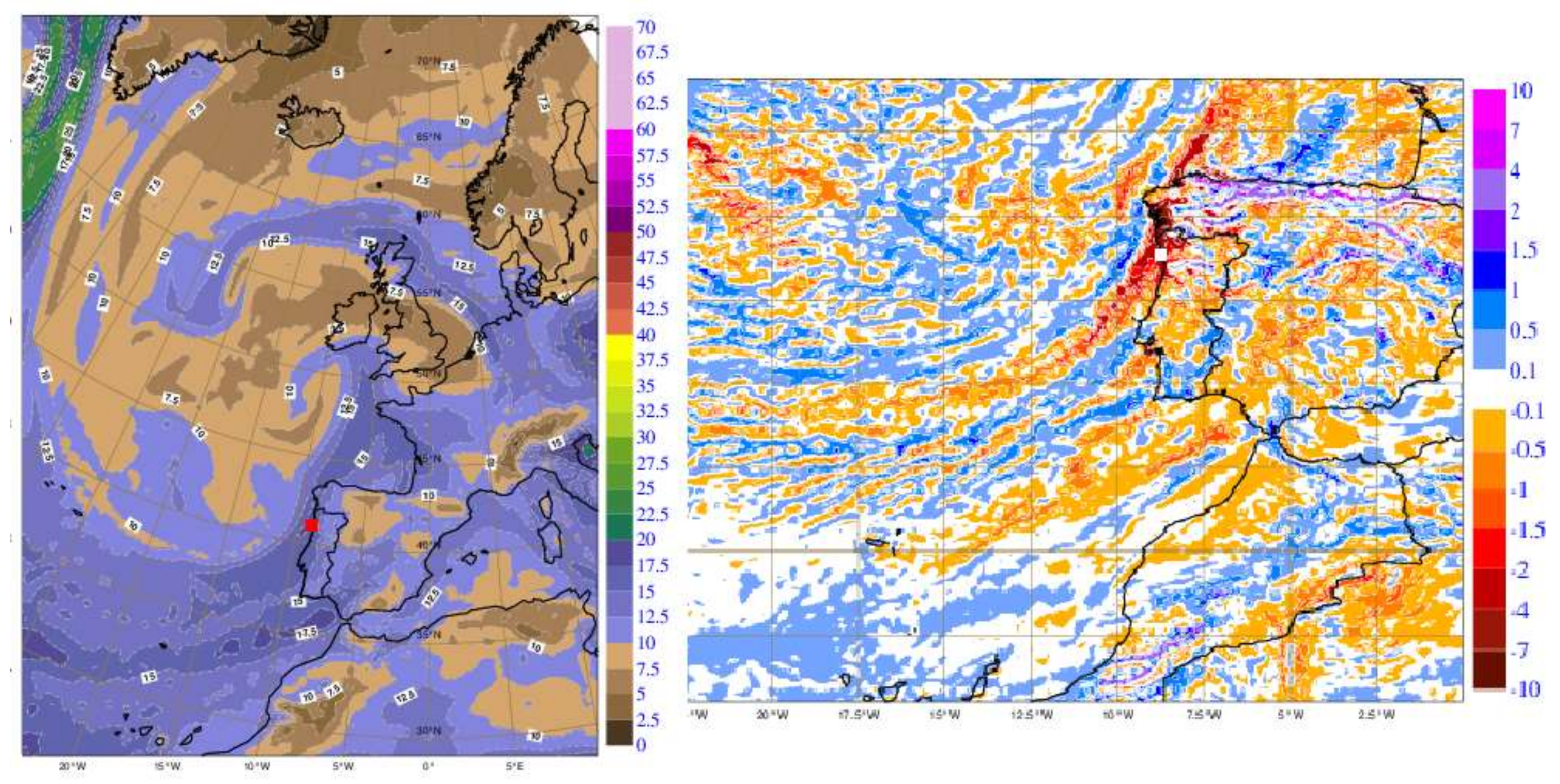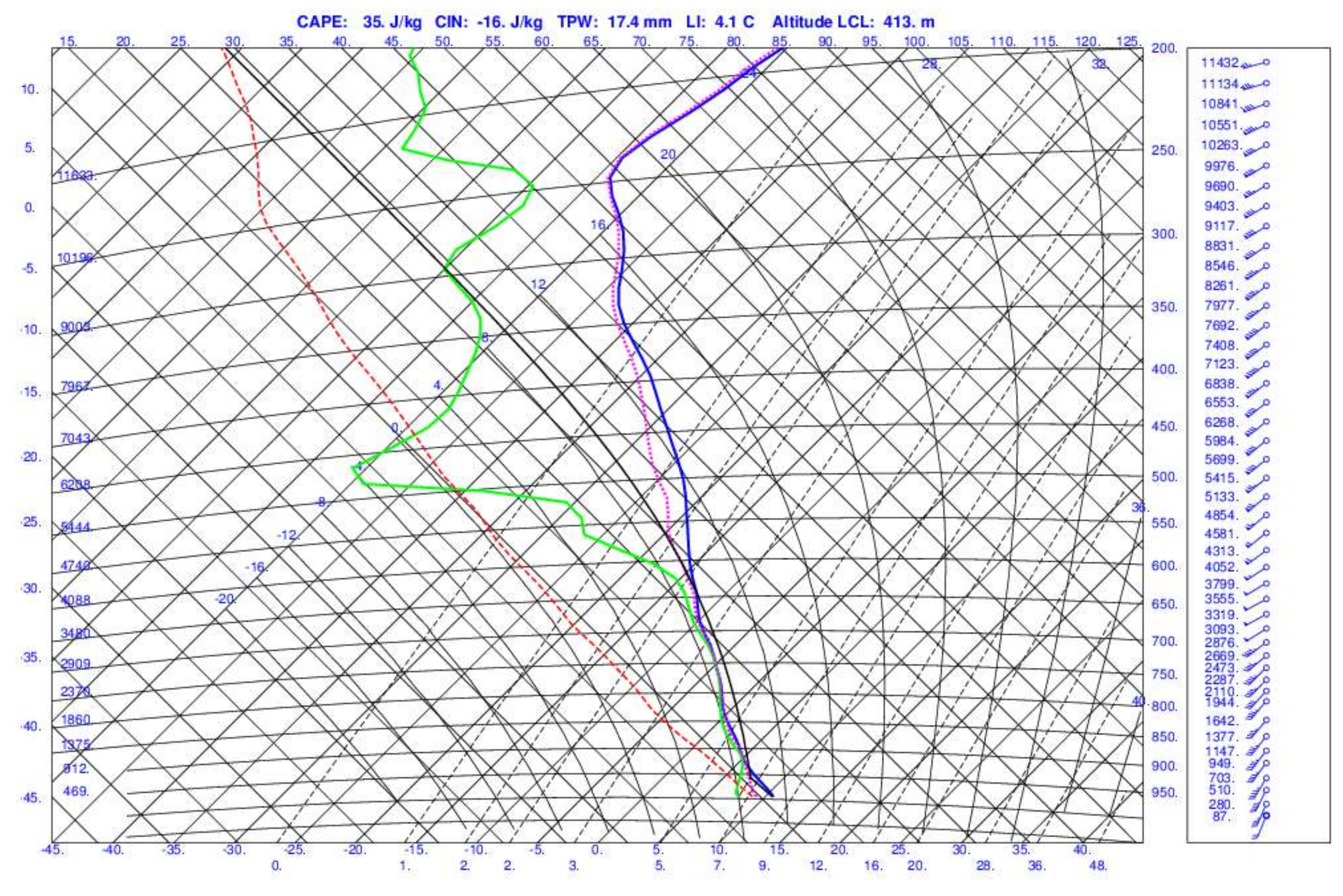1. Introduction
Unlike other meteorological phenomena for which instrumental observations are sufficient, the study of tornadoes requires the presence of an observer and a specific system for collecting the observations. There is a long history of tornado observations in Europe, back since the Greek and Roman natural philosophers. However, there are many inconsistencies both in the observational networks and in reporting practices across the different European countries. Organized and centralized tornado records have been kept in the United States of America (US) since the 1950s [
1], and they have shown that the reported frequency and intensity of tornadoes is lower in Europe when compared to the U.S. Thus, tornadoes did not become a priority for the European meteorological services, although the true magnitude of their risk in Europe is unknown, due to the lack of assembled datasets [
2].
A tornado climatology is important for better quantifying the threat posed by tornadoes, but also for understanding the genesis and characteristics of severe convective storms, as well as to assess possible trends due to climate change [
3]. In recent years, efforts have been made to collect reports at the European level for a more consistent tornado climatology. These efforts were based on historical collections of tornado reports, case studies, and local climatology reports [
2,
4,
5].
Since tornadoes are microscale phenomena, the probability of these events being observed from meteorological stations is low. Therefore, tornado records in the synoptic meteorological database are rare. By the end of the 20th century, most meteorologists considered that tornadoes did not occur in Portugal, classifying any damaging wind event as a “high-wind event”. After photographic evidence of a tornado in 1999, which occurred in Vila do Conde (northwestern coast of Portugal), and the posterior study of this event [
6], other previous events were unveiled, suggesting that a new approach to these phenomena was needed. This included the study and the registration of each report [
7,
8,
9,
10]. Until 2020, there were 195 reports classified as tornado events over land or at sea off the coast of mainland Portugal, Azores, and Madeira Islands; 63 of which were documented with photo or video records, and 4 events were captured by weather stations. Evidence of tornadoes was found in 42 reports prior to the year 2000.
The distinctive characteristics of tornadoes and their effects, the increasing use of digital cameras, mobile phones, as well as the growing role of social media, have contributed to an increasing number of known events. Consequently, in the past couple of decades, awareness about the impact of tornadoes and their consequences to the people, territorial planning, and to the action of civil protection authorities has also increased.
A weather radar network was deployed over mainland Portugal, consisting of 3 C-band Doppler radars, which have been operational since 1998, 2005, and 2015 (respectively). The combined use of their observations with conceptual models has been allowing better insight on the identification of specific radar patterns related to organized convective systems [
11,
12,
13]. The collection of tornado events has motivated a systematic classification of the series according to the proposed and recently reviewed tornado taxonomy [
14,
15] (see
Appendix A for details on the taxonomy). The most damaging tornadoes were classified as supercell tornadoes [
15]. This result is not surprising and it agrees with a recently detailed case study [
16]. The most interesting finding was that a relatively large proportion of weaker and shorter-lived, but still damaging, tornadoes was associated with line echo wave patterns (LEWPs) [
15]. Radar observations over Portugal suggest that most of these tornadoes were spawned by mesovortices embedded in squall line-type formations, such as observed over other geographical areas [
17].
The aim of this paper is twofold. On one hand, it intends to contribute to the general climatology of tornadoes in Europe by presenting a tornado climatology for Portugal. On the other hand, it presents a sorting of tornado types (TT) following the taxonomy proposed by [
15], together with an assessment of the different synoptic regimes and atmospheric environments that favored their occurrence in Portugal. The definition of a tornado and the methods that were used to collect tornado reports, as well as the methods to apply the tornado taxonomy and to characterize the typical atmospheric environments of each type, are described in
Section 2. A climatological characterization of tornadoes in Portugal is presented in
Section 3. The results of the tornado taxonomy classification for Portugal are presented in
Section 4.
Section 5 includes two well-documented case studies. Discussion and conclusions are provided in
Section 6.
3. A Portuguese Tornado Database
All data collected until 1 January 2020 were studied, revealing 195 reports validated as tornado events near the coast or in mainland Portugal, Azores, and Madeira Islands. There were 4 events captured from weather stations. As
Table 1 shows, the validation of 63 events was based on trusted videos or photos (34 of tornadoes over sea, near the coast, and 29 of tornadoes with reported effects over land) and 50 events based on trusted eyewitness description of the phenomena (5 tornadoes over sea and 45 with reported effects over land). The vortex was not seen for the remaining 82 events (radar data enabled the diagnostic of a tornadogenic structure for 49 of these events). However, they were validated with the available data, including reports of local authorities and witnesses, and through site survey in 16 events.
All the 39 events over the sea were seen from the coast, usually from high places with a wide landscape. Five of these events were documented with precise description, and 34 with photos or videos of the vortex touching the sea surface. There was also footage of 11 more events over the sea that later made landfall. The footage of 18 tornado vortices over land and the witness description of 45 more events showed they had many different shapes; sometimes the vortex was clearly visible, and other times it was difficult to perceive. There was also footage of multi-vortex tornados.
On-site damage survey was conducted by meteorologists of IPMA for 19 events, and also by local civil protection services or trusted witnesses for another 16. For some events, available data was not enough to determine all characteristics that should be recorded, thus the final database is incomplete. The registered cases clearly underestimated the number of tornadoes that were known to have occurred, being likely that some tornado events were excluded due to lack of suitable data.
3.1. Historical Tornado Reports
Evidence of a tornado was found in 42 reports of events that occurred until 30 December 2000. Although a systematic data survey on historical tornado reports was not conducted, the available data on possible tornadoes was collected and investigated using newspaper reports and, whenever possible for more recent events, visiting the sites and contacting eyewitness and local authorities [
7].
Weather station archives have recorded evidence of 2 tornadoes: (i) On 6 November 1954 at 12:50 a.m., a tornado destroyed the Castelo Branco Weather Station, causing a sudden drop from 1013 to 986 hPa and subsequent recovery in less than 15 min time lapse on the barograph record. Newspapers reported F3 damage for a path longer than 9 km, crossing the entire town. (ii) The “Annual Climate Report of Serra do Pilar Weather Station” referred that a tornado over water moved inland for several km, causing devastating effects in January 1941. A weather service site survey [
27] reported F2 damage in houses and trees along a 4 km path, from SW to NE, on 13 December 1996 at 8:15 am, at Santiago do Cacém. The vortex was not seen, so this event was classified as a “devastatingly strong wind event” because it was commonly believed that tornadoes would not happen in Portugal. Moreover, photos of 4 different tornadoes were found in private collections of data.
During the 19th and the 20th centuries, newspapers often referred to the weather and weather damage; and the words “ciclone”, “furacão”, or “tufão” (in Portuguese), nowadays used in atmospheric science to refer to a “cyclone”, a “hurricane”, and a “typhoon”, respectively, were at that time popularly used to refer to any damaging wind storm. Recent studies of tornadoes and other classes of wind storms have shown how some deep lows or cold fronts may cause similar damage. However, when the more spectacular effects of tornadoes were described, the event could be classified as tornado. The first tornado event occurred on 24 February 1370 in Lisbon. The report was found in a 19th century newspaper list of weather events, referring that day “a furious furacão” caused heavy damage in the town. It blew open and carried halfway into the church the heavy iron doors of Lisbon Cathedral, which were locked.” The church archives confirmed there were important rebuilding works, including the bell tower, just after that date. On the evening of 21 June 1849, a strong thunderstorm caused a path of heavy damage of about 100 km in the Alentejo region (southern Portugal). Using current state-of-the-art knowledge, it is more likely that some of the damage path was actually caused by rain and hail, and that an F3 intensity tornado caused the reported heavy damage in houses and forest, the killing of cattle, and the debarking of strong and flexible bushes. A precise description of a tornado over the sea near Espinho (northwestern coast of Portugal), on 11 October 1863 at 9 am, was referred in the newspaper as a “beautiful phenomenon”, well known by the sailors as a sign of stormy weather. There are several reports of the 13 December 1864 events, when 4 tornadoes occurred. Precise description of serious damage in buildings at 10:30 a.m., along a 11 km path crossing the city of Lisbon from SW to NE, allowed its classification as F2 tornado. On 16 December 1989 at 8:20 p.m., an F3 tornado caused heavy damage in the forest and on 300 homes (4 of them collapsed), for a path longer than 11 km, from SW to NE, at Mangualde (central region of Portugal).
Although it was not possible to collect important data on most of the events, it is known that there were tornadoes of strong intensity with important losses of property, a substantial number of injuries and occasional casualties, but most events had a very local impact and soon were forgotten. Before the middle of the 20th century, the public and the weather services knew that tornadoes were unusual events, but they could happen near the coast of Portugal and they could make landfall. There was little knowledge about “devastating twist winds” events inland, since tornadoes—which usually affect small areas—were sometimes difficult to identify.
3.2. Tornadoes over Mainland Portugal and near the Coast
The geographical distribution of 182 tornado events in mainland Portugal and over the sea near the coast until 1 January 2020 is shown in
Figure 1. The tornado frequency was higher near the coast (more than 25% formed over the sea), with 24 tornadoes occurring over the sea along the west coast, and 6 over the sea along the south coast. From the 154 tornadoes observed over mainland, there was documented evidence that 21 of them formed over the sea and made landfall afterwards. From the northeastern mountainous region of Portugal, there were very few reports. There were 2 tornadoes over Tagus River: one was over water with no damage reported; the other formed over water and moved inland, affecting Lisbon, with F1 damage along a 4 km path in town, on 14 April 2010.
Relevant effects were documented in detail, even for some events that happened a long time ago. Reported damage allowed the intensity estimate for 141 events, as shown in
Figure 2, with most tornadoes classified as F1 and F2 intensity using Fujita scale. The impact that strong tornadoes have on society is more likely to be remembered and referred. That is why half of the strongest tornadoes (classified as F3) were reported before the year 2000. Although these phenomena are so impressive that even the damage caused by weak events was described in detail on newspapers, F0 and F1 tornadoes affecting very small areas may probably remain under-reported.
Collected data allowed an estimate of the path of 121 tornadoes. Some reports provided accurate information of where the tornado was formed and where it dissipated, but often, over some sections of the path, it could not be accurately tracked because there was not any ground damage. For this reason, and because it was hard to collect enough data, the total lengths were usually underestimated. Interpreting the effects on the ground in order to track the trajectory described by each tornado was even more complex in the case of multi-vortex tornadoes, since their trajectories did not follow a straight line. There were also reported cases where the tornado temporarily lost contact with the ground. Path characteristics were not evaluated for events over water and the total length was underestimated when the tornado formed over the sea and later made landfall, or crossed grassland or coastal marshland. Path length ranged from a few hundred meters to more than 50 km, with two thirds of the tornadoes presenting a trajectory up to 5 km, as shown in
Figure 3. Paths were longer than 50 km for two well documented F3 events. Radar observation allowed the follow up of a convective cell for a more than 80 km path from W to E, on 4 March 2018, producing 2 tornadoes in southern Portugal and one other in Spain. These were classified F1 intensity after the report of effects on the ground.
It is uncommon to gather data enough to estimate path width, but it is possible to state that it did not exceed a few hundred meters during the most intense events. Path direction usually followed the synoptic flow, thus most of the events were moving from the south or from the west.
Distribution of tornadoes per month, considering 179 reports, can be seen in
Figure 4. Summer events are unusual, with only 10 events being reported for June, July, and August. The larger number of tornadoes in December before the year 2000 is associated to the 4 reported events on 13 December 1864.
Considering only the 142 reported events after the year 2000 for a more consistent analysis, the months with a greater number of events were March, October, and November (with almost half or the total events, i.e., with 22 reports for each month), although the most intense tornadoes occurred during April, November, and December. This result suggests more suitable atmospheric environments for tornado to occur from autumn to early spring. Given the climate characteristics of the region, the inter-annual variability is high, with the number of reports per year varying from 1 (in 2005 and 2019) to 18 (in 2010), as shown in
Figure 5. On average, 6 tornadoes per year with effects over land were registered during the considered 19-year period. The under-reporting of weak events may have contributed to this result, especially over the earlier years of the dataset. In recent years, with the increasing use of portable video cameras, better understanding of the phenomena and an increased awareness of the public and weather services, under-reporting has decreased. Nevertheless, some events were still of difficult interpretation and may have been excluded when tornado damage happened during a heavy rain and strong wind event.
No pattern was found for the distribution of tornadoes along the day. The study of the synoptic regime for each event (see
Section 4 below), showed that the contribution of large-scale forcing is more significant than the diurnal forcing, justifying tornado occurrence at any time of the day/night.
In most cases, available data were not enough to assess the duration of the tornado, but some tornadoes over the sea were observed, or even filmed, from the beginning to the dissipation stage, usually lasting for about 5 min. On some occasions, the duration of the tornado was estimated with the help from successive radar observations of the parent convective storm, from the beginning to the end of the path of known effects. It was often observed that the parent storm was already formed some time before the effects on the ground were felt. The longest-lived event lasted for 45 min, causing F3 damage for a 54 km path, on December 2010 [
16].
Tornado density was computed for each point by dividing the number of events within a 50 km radius, by the corresponding surface area.
Figure 6 shows the spatial distribution of events per 10,000 km
2 and per year, estimated considering 114 reports of tornado over land (an area of 89,015 km
2), for the period between 1 January 2006 and 1 January 2020. The map revealed that there are more than 0.6 tornadoes per 10,000 km
2 and per year in the areas with higher tornado activity. The region in the center of the map is known as the Portuguese “tornado alley”, and corresponds to the southern part of a mountain range that extends north of Lisbon, to the northeast. Observations suggest that this mountain range may play a role in the activation of tornadic storms. A smaller region, at the northern part of the west coastal area, around Porto (second largest urban area in Portugal) also received more than 0.6 tornadoes per 10,000 km
2 and per year. The southern coastal area, also densely populated, ranked second in the national tornado average. The northeast mountainous area of the country, revealing less than 0.1 tornadoes per 10,000 km
2 and per year, showed the lowest tornado activity. Underreporting seems likely in the southern region of Alentejo (main towns Évora and Beja), given its lowest population density, and because the landscape is characterized by large grassland areas with scattered trees, where tornado damages are hard to trace.
3.3. Impact of Tornadoes in Mainland Portugal
The tornadoes that occurred in Portugal had an impact on the territory, the population, and the local economy. However, most of the damage affected families and private companies, so an estimate of the total losses is hard to assess. The most frequent damages were on roofs, chimneys, trees, and electricity and telecommunications poles. The cover plates of industrial buildings, with a large surface exposed to the wind, were often lifted, and sometimes completely removed. Cars were often damaged, due to the falling of trees, or because they are hit by projected debris, or even because they are sometimes dragged and turned upside-down.
Some events have resulted in extremely high losses. Many business facilities and dozens of industrial pavilions were affected, some were totally destroyed. Severe damage to the forest, to farms, including the loss of animals and the destruction of warehouses and greenhouses was reported. A solar energy production facility was completely destroyed. Profound damage to housing has occurred, forcing many families to relocate, as was the case on 18 October 2006 when a tornado affected about 200 homes at Vila Nova da Barquinha.
Usually, tornadoes do not cause victims, but sometimes people are hit by airborne debris or dragged by the tornado, and there is one record of a heart attack. A total of 344 people were injured as result of 28 events. Several casualties were reported for the events of 13 December 1864. On 6 November 1954, the Castelo Branco tornado caused 5 deaths, and one more person died due to the Portalegre tornado on 10 September 1985, and one more after a mobile-home was overturned, during the Silves tornado on 16 November 2012.
Long-term damage is rarely reported. One example was the case of a company with 29 workers gone bankrupt one year after being hit by an F2 tornado on 7 December 2010. On the same day, an F3 tornado hit a kindergarten class, causing emotional trauma to the children, which justified a mental health intervention during the following year. Feelings of sadness and hopelessness were also reported for several years after tornado damage.
3.4. Tornadoes at Azores and Madeira Islands
Tornadoes over the ocean are known since the 16th century. Collecting reports for Madeira and Azores islands in the Atlantic Ocean begun after the year 2000.
For Madeira Island, located at 33°N 17°W, with a total area of 800 km2, there is footage of 5 tornadoes over the sea near the coast, reported on 30 October 2006 (this one near Funchal harbor), \ 21 November 2008, 29 April 2011, 26 October 2016, and 25 October 2018. Footage of this last event shows the tornado lasted for more than 5 min over the sea. There are no reports of tornado damage in land, perhaps because this is a very small mountainous island and all the coast is a cliff.
For the Azores, a group of 9 small and mountainous islands, at a region around 38°N 28°W, with a total area of 2346 km
2, there is footage of 4 tornadoes over the sea near the coast, observed during a period from 2 to 5 min on 18 December 2006, 27 September 2011, 6 August 2012, and 17 April 2016. A tornado in S. Miguel Island on 26 September 2011 was confirmed by several eyewitnesses and a photo. The local survey conducted by the weather service confirmed it was formed in a flat area, causing F1 damage on 20 houses (2 families became homeless) and trees, along an S to N 0.7 km damage path. On 23 January 2016, a tornado caused F1 intensity damage on houses and vegetation along a 3.7 km path from SW to NE, on Santa Maria Island, according to the local survey [
51]. The grassland near the sea did not show visible effects to confirm if this tornado was formed over the sea and later made landfall.
4. Tornado Taxonomy, Synoptic Regimes, and Atmospheric Environments (1 January 2006–1 January 2020)
For the period between 1 January 2006 and 1 January 2020, a total of 120 events were classified after the proposed classification methodology (described in
Section 2.2), resulting in the identification of cases belonging to 9 out of the 13 proposed TT [
15], namely Type Ia (discrete supercell; 19 events), Type Ib (discrete low-top minisupercell; 34 events), Type IIa (LEWPs; 33 events), Type IIb (bow echo; 1 event), Type IIc (bookend vortex; 7 events), Type IId (inflow jets along QLCS; 2 events), Type IIe (mesovortices not associated with LEWPs, bows, or inflow jets; 8 events), Type IIIa (landspouts; 6 events), and Type IIIb (waterspouts; 10 events). Each of the identified TTs occurred during the onset of typical synoptic regimes over Portugal, hereby synthetically described using the datasets described in
Section 2.3.
Type Ia tornadoes were usually identified very close to frontal boundaries that, in turn, were associated with extra-tropical depressions located to the west of Iberia. These were settled on warm, moist, unstable airmasses. The lows were nearly stationary or slow moving to the NE, thus promoting south-southwesterly flows over the territory, which were usually strong. The atmospheric environments were frequently characterized by the presence of an upper level jet streak that, along with positive vorticity advection in place at mid-levels, promoted the right setting for supercells to develop. These were found to organize both in the pre-frontal warm sector as well as in the postfrontal area. Typically, frontal boundaries (including instability lines) became stationary for some time. The strongly sheared environment in a deep layer was frequently in phase with low level veering. This environment was sometimes supportive of long-lived supercells (lasting in excess of 2.5 h), whose relevance has been discussed in the literature [
38]. From the most intense and longest damage path tornadoes that occurred in Portugal, a large fraction has occurred under this regime, spawned by supercells, as can be seen in
Figure 7 and
Figure 8. A detailed discussion mainly supported by radar observations of one event of this TT will be done below in the following section.
Type Ib tornadoes were typically observed under synoptic regimes that did not substantially differ from the ones associated with Type Ia. The main differences were the smaller amounts of available instability during Type Ib regimes, as well as a not so strongly sheared environment both in the low and deep layer. Although the distinction between Type Ia and Ib environments was not striking, it seems that there was less supercell organization during Type Ib events due to less vertical shear in the deep layer, which in turn generated shorter-lived tornadoes. Moreover, in those cases, it was more unlikely that supercells could bring vorticity closer to the ground, due to less low-level layer shear, thus not sustaining as strong tornadoes. This lower proportion of stronger tornados of Type Ib can be verified in
Figure 7. The TT classification for Portugal showed that low top supercell tornadoes were the most frequently observed, along with the Type IIa tornadoes.
Type IIa tornadoes (LEWPs) were typically observed either along the cold frontal boundary itself or along instability lines (or squalls), developing upwind or downwind of the main boundary. An event of this type over the UK has been discussed by Clark [
17]. All these boundaries were mainly associated with low pressure systems located over the NW of Iberia, or even further N, to the NW of the British Isles. Usually, the location of these lows promoted the advection of relatively moist, moderately unstable, and cold air masses over western Iberia, driving westerly or northwesterly flows over the Portuguese territory. An upper level jet streak was sometimes present but frequently not overlapping with substantial instability areas. It was also verified that, in general, the events with the largest values of deep layer shear for this type, were in phase with lower instability areas and conversely. During those events, short-lived mesovortices embedded in the LEWP were supported and very abundant along the instability lines. Usually, the boundaries were propagating progressively over the territory and not stalling. The strongly sheared environment in a deep layer was frequently in phase with low-level shear. However, this low-level shear was commonly of the shearing type, with modest veering if any. LEWP corresponds to “a special configuration in a line of convective storms that indicates the presence of a low-pressure area and the possibility of damaging winds and tornadoes. In response to very strong outflow winds behind it, a portion of the line may bulge outward, forming a bow echo” [
52]. It was found that while the most damaging tornadoes were classified as Type I (namely, Ia and Ib), a relatively large proportion of weaker and shorter lived but still damaging tornadoes were classified as Type IIa, as shown in
Figure 7. A recently published pan-European climatology of tornadoes [
2] shows that tornadoes over southern Europe include a reasonable amount of non-supercellular tornadoes. In Portugal, the more abundant non-supercellular tornadoes are thought to be generated by these mesovortices and were typically cool-season events. In fact, from the 33 events of this type, only 4 did not occur in the period from mid-October to mid-April (
Figure 9). One event of this TT will also be discussed ahead in more detail, with the support of radar observation.
Tornado Types IIb (Bow echoes) and IId (Rear Inflow jets along sections of the QLCS) were seldom observed in our study, and a “typical” synoptic regime could not be defined. The only case of Type IIb was observed in a strong westerly flow over Iberia that promoted the advection of a relatively warm, moist, and unstable air mass. The ingredients were similar to those of events leading to Type Ib tornadoes, although in this case, there was a slightly drier environment. Type IId was identified twice, during late summer (
Figure 9) and on both occasions, under the influence of a slow-moving synoptic boundary over the territory. In events of this type, an extremely moist, unstable, and warm air mass was in place, along with a strongly sheared environment, both in the deep and low level layers. However, low-level shear was of the shearing type, as in the case of Type IIa.
Tornado Types IIc (Bookend vortex) and IIe (non-specific mesovortices) were observed under synoptic regimes which sometimes were similar to the ones associated with Types Ia and Ib and in other cases, were similar to the ones more typically associated to Type IIa. The small-scale phenomena described as bookend vortices and other non-specific mesovortices have some similarities both with mesocyclonic structures—typical from supercell types—and with structures embedded in QLCS, such as mesovortices. Those similarities may be related to the fact that their parent synoptic regimes are also similar.
As to TT IIIa (landspouts), they were mainly observed in regimes dominated by the Iberian thermal low, typical from the warmer months (
Figure 9), and occurred far away from synoptic frontal boundaries. The air masses used to have only low to moderate instability, being the less unstable at a synoptic scale, among the ones under analysis. The environments were not only relatively dry, but also characterized by elevated based convection. Both deep layer and low-level vertical shear were small.
The TT IIIb (waterspouts) was observed close to slow moving frontal boundaries and, at least in one case, close to a convective outflow. The main differences of their environment to their land counterparts were slightly less available instability and higher low-level vertical shear.
The distribution of TT along the year was similar to the one already presented for the overall set of tornado events, clearly showing the dependence with synoptic climatology. The dry season in Portugal runs from June to September, where rainfall is scarce, the only exception being the rain from convective storms that may develop mostly inland. Nevertheless, the frequency and severity of this summer convection is much lower than over central Europe.
This qualitative analysis showed that atmospheric instability was larger in environments that favored Types Ia and Ib tornadoes, as compared to that of environments that supported the other types. The Type IIIa (landspout tornadoes) and IIIb (waterspout tornadoes) were the ones associated with the least unstable environments, especially in the case of the latter.
The environments prone to Types Ia, Ib (supercell and minisupercell tornadoes), and IIa (LEWPs tornadoes), tended to be moister than the ones more supportive of Types IIIa and IIIb.
Vertical wind shear of the horizontal winds for the low layer (namely for the 0–1 km AGL) was evaluated and it revealed much lower values in environments prone to Types IIIa and IIIb (non-mesocyclonic tornadoes). As to the deep layer shear (0–6 km AGL), it was verified that the larger values were associated with environments that favored supercells, both classical and mini or low topped (Types Ia, Ib). Types IIa were also characterized by large amounts of the observed deep layer shear, whereas the ones of the other types were considerably lower.
At last, distribution of the LCL (lifted condensation level), frequently used as a proxy for cloud base, was considered. It was found that significantly lower values of LCL, characteristic of environments with high low-level moisture, were associated with TT Ia, Ib, and IIa. Types IIIa and IIIb were observed in environments favorable to higher based convection.
On those environments that were more supportive of supercells in Portugal, there was an overlap of larger instability and larger deep-layer shear. This result is in line with the literature on this subject [
37]. Moreover, these environments were usually characterized by lower LCL values. This highlights the importance of evaluate LCL distribution on those environments, since low LCL values in supercells supportive areas are a sign that tornadogenesis may also be more likely, as the release of instability will probably occur closer to ground level.
6. Discussion and Conclusions
A systematic data collection and study of the tornadoes has been conducted since the year 2000, revealing 195 tornado events. Over land, there are records on tornadoes since the middle of the 19th century, and references back to the 14th century. Over the sea, there are references to tornadoes since the 16th century. Tornadoes over the Atlantic Ocean were sometimes observed from Madeira and Azores Islands and from mainland Portugal. When making landfall, those tornadoes often caused significant damage. In mainland Portugal, 154 tornados were reported, 21 of them were formed over the sea and moved inland. For Azores Islands, 2 events of F1 tornado damage were reported.
The tornadoes that occur over mainland Portugal have an impact on the territory, the population, and the local economy, but most of the damage affects families and private companies, so the estimate of the total losses is hard to assess. Most of the events had a local impact and soon were forgotten, but some caused important losses of property and occasionally, several injuries, or even deaths, resulted in long term consequences that are rarely reported.
Interpreting the effects of the tornado on the ground to order to delineate its trajectory and access its intensity is a complex task, because it depends on the characteristics of each tornado, on the type of structures lying along its path, as well as on the accuracy of the available data. This may have resulted in a path length and intensity underestimation for some events. There is also limited consistency on the available data due to the use of different methods in damage survey. Although underreporting has been reduced in recent years, earlier tornado records were mostly based on newspaper reports, and even for recent events, it was not always possible to collect all the relevant data. Evidence of well documented events shows that most tornadoes lasted less than 10 min, causing F1 or F2 intensity damage, and their paths were usually smaller than 5 km. The strongest 6 reported tornadoes were classified as F3. Half of them occurred before the year 2000, but two recent events were confirmed to have lasted up to 45 min with paths longer than 50 km.
A classification on tornado types revealed that the strongest and longest damage path tornadoes in Portugal were associated with supercells (Type I tornadoes). Supercell tornadoes accounted for about 44% of the total occurrences and were commonly identified close to frontal boundaries. The corresponding low-pressure systems were located west of Iberia, usually slow moving to the NE, therefore promoting south-southwesterly flows. Their environments were warm, moist, and very unstable, and they were characterized by strong deep-layer shear and low-level veering, which were in phase with each other. Tornadoes that occurred in the Portuguese “tornado alley” and in the southern coastal area, were mostly of this type, exceeding 0.6 tornadoes per 10000 km2 and year. However, nearly the same fraction of tornadoes (43%), originated in QLCS (Type II tornadoes). The large majority of these, almost one third of the total tornado occurrences, 28%, originated specifically from line echo wave patterns. These patterns developed close to, or along synoptic boundaries. The lows were typically located NW of Iberia or even further N, promoting west-northwesterly flows in relatively moist, moderately unstable, and cold air masses. These environments were characterized by strong deep-layer shear and low-level shearing. However, instability and shear were not frequently overlapping. These weaker and shorter-lived, but still impacting tornadoes, were found to be the more frequent non-supercellular tornadoes in Portugal, and were observed to be typically cool-season events. Tornadoes that occurred in the northern part of the west coastal area were mostly of this type, also exceeding 0.6 tornadoes per 10,000 km2 and year. Both Type I and Type II tornadoes were found to follow a bi-modal distribution, with one frequency maximum during late winter/early spring and a second during autumn. Another kind of non-supercell tornadoes, the so called fair weather land and water spouts, accounted for only 13% of the total amount of tornadoes during the 14 year classification period. These were weak and short-lived tornadoes (Type III). Landspouts have occurred far from synoptic boundaries and waterspouts were generally close to slow-moving frontal boundaries.
A qualitative comparison of the annual tornado density with the adjacent Spanish areas shows that the relative maxima in northwestern and southwestern Spain [
54] merge with the corresponding areas of maximum density over Portugal. Most tornado path directions were from south and southwest, as well as in Spain [
54].
Unlike documented for other regions of southern Europe [
4], there was no clear frequency increase during summer months. Tornadoes usually occurred from October to April with very few summer reports. There was a high inter-annual variability on the number of tornadoes in Portugal in line with the variability of the regional synoptic climatology. This variability was mostly related to the cooler months, since during the warmer period, there were almost no tornado reports. The yearly distribution of tornadoes in mainland Portugal was found to follow a bi-modal distribution, with a peak in late winter–early spring and another one during autumn. This distribution differs from the one observed over other southern European areas, where there is a peak starting in late summer [
54], and also from the distribution observed over the westernmost European areas, where the peak is during summer [
4]. During summer, mainland Portugal is mainly under the influence of dry and stable air-masses, in the joint circulation of the Azores high and the thermal Iberian low. By fall, as the polar front starts to influence the area, the arrival of moist but still warm air-masses explains the autumn tornado peak. During late winter/early spring, as the polar front migrates further north, the area is again more exposed to westerly flows, also creating environments which favor tornado formation. The distribution of tornadoes per month of the year of the classified tornado types also reflected the synoptic climatology of mainland Portugal territory. The registered cases likely underestimated the number of tornadoes that have indeed occurred, since there were tornadoes that were not observed and/or reported. Some of these cases could have had minor effects, which were not appealing to the media; other cases could have had reduced spatial and temporal scales, which made their identification difficult.
In the future, there will be a continued effort regarding the systematic collection of tornado data, including the classification of types and assessment of their typical environments. The ERA5 reanalysis data will certainly provide a sound base to more reliably assess the environmental conditions of convective storms, since it provides analysis fields at a much better spatial (horizontal resolution of 31 km and 137 vertical levels) and temporal (hourly) resolution than those of the datasets used in this work. This tool will allow the development of statistical metrics based on several atmospheric parameters that will increase the insight on the balance between atmospheric ingredients that characterize tornado prone environments.
